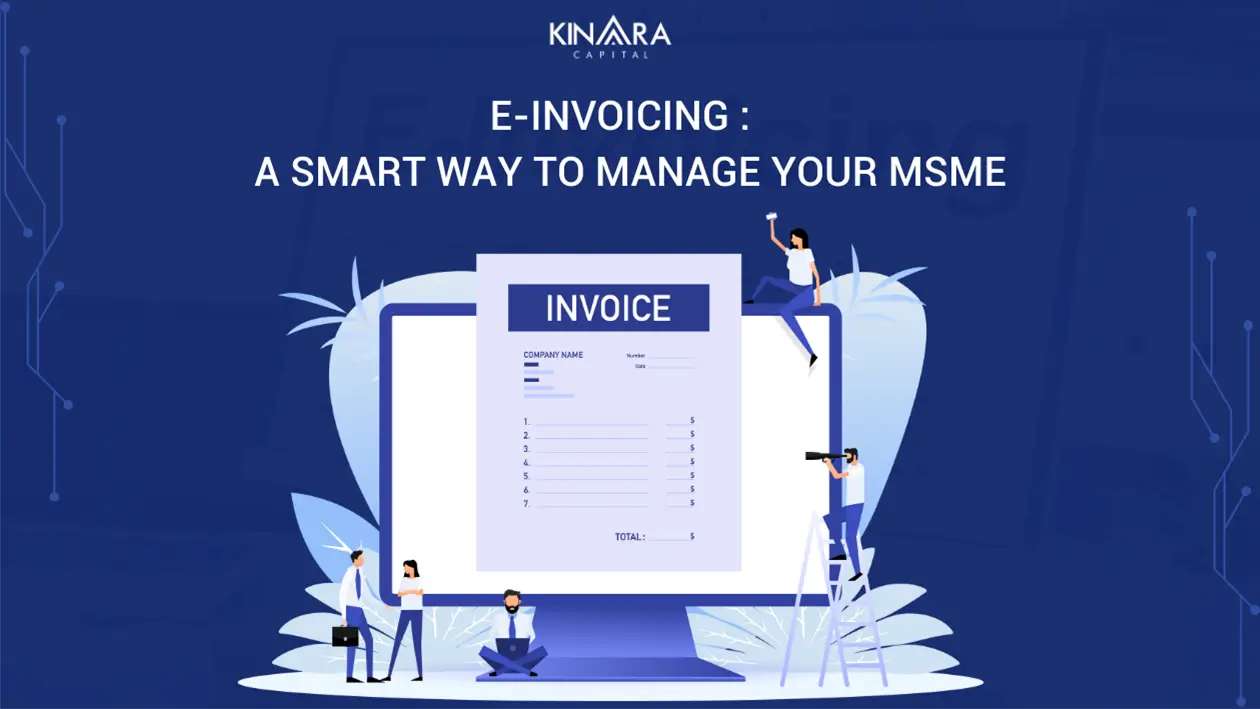
Businesses purchase and sell all manner of goods and services to support their operations. For each transaction, an invoice is generated, which could follow any suitable format for the seller. These invoices are further used for taxation and financial management purposes, but their non-standard formats often reduce interoperability and machine readability across management and regulatory systems.
As businesses digitise, this particular challenge is also being addressed with the adoption of e-invoicing. In this article, we will discuss e-invoicing, its constituents, its benefits, and the process for getting e-invoices for your MSME business.
E-Invoicing is the process of generating, issuing, receiving, processing and authenticating B2B invoices electronically. E-invoices can be generated by manufacturers or traders and issued by suppliers to their B2B customers for bill settlement. E-invoices are prepared in a standardised format and authenticated by the Goods and Service Tax Network (GSTN).
As of April 2022, e-invoicing is mandatory for all businesses with an aggregated turnover of more than Rs. 20 Crore. The aggregate turnover includes the turnover of every GSTIN registered under a single PAN. However, certain business types are exempted from this mandate, such as an NBFC, insurance or banking company, a Goods Transport Agency, an SEZ unit, and a government department or local authority.
The older, non-electronic invoicing process required the manual creation of invoices for sale and purchase transactions. Individual transactions had to be carefully recorded to maintain day-to-day activities. There was no standardised format or software for generating invoices, and entire records had to be manually reviewed to file GST returns for the business. Based on the type and size of the business, this activity could occur at the end of every month, quarter, or year.
With e-invoicing, this is no longer needed. E-Invoices are created in a GST-compliant schema and pushed to the Invoice Registration Portal (IRP). The invoice details are automatically stored in the IRP and are pushed to the GSTN at 24-hour intervals. For MSME businesses, this means auto-population of ANX-1 (Annexure 1) of the GST return form for the outward supply of goods and services. This leads to substantial savings in terms of time, cost, and effort.
The automated generation of e-invoices and data transfer to GSTN is possible because of a standardised schema and format followed for e-invoicing. Therefore, each e-invoice must comprise certain essential components for interoperability and authorisation. These components are:
All the other details (such as your GSTIN, invoice date, tax schema, etc.) can be set as per the specific needs of your business. GSPs typically provide multiple options to choose from and include all the necessary information in each format. But any invoice can only truly become an e-invoice when it has the above three mandatory components, i.e., the IRN, QR code, and digital signature.
Your selected GSP can automate the GST filing process with e-invoicing through the following steps:
While automated GST filing is an unparalleled benefit of E-invoicing, the practice offers several other benefits for businesses adopting e-invoicing. These are:
E-invoicing under GST helps to ensure better data reconciliation and reduction of data entry and mismatch errors. This is done by the real-time exchange of invoice data between the supplier and the buyer. Every invoice generated and accepted by the buyer is automatically updated in the GST portal. This ensures that all transactions are tracked and monitored in real-time, preventing any discrepancies from occurring. Furthermore, the data is directly fed into the GST portal, eliminating the need for manual data entry and reducing the risk of errors.
E-invoicing provides an automated, standardised and secure way of exchanging invoice data between buyers and suppliers. It helps improve interoperability and machine readability of e-invoices generated on one software by another. This makes the process of exchanging and processing invoices simpler and faster by eliminating manual tasks and manual errors. As a result, businesses save time and money, as well as gain better visibility over data and transactions. E-invoicing is also beneficial for increasing collaboration and trust between trading partners. All these advantages result in increased efficiency and cost savings for businesses.
E-invoicing is a great tool for real-time tracking of supplier invoices and improved accounts management. It streamlines the invoicing process by providing an efficient and secure way to receive, process, store, and send invoices. This helps to reduce manual data entry and eliminates the need for paper invoices. It also allows businesses to track invoices in real-time, enabling them to manage accounts more effectively. E-invoicing also helps to reduce errors and fraud, as it provides a secure system for monitoring and recording invoice payments. This improves accuracy and helps businesses to obtain better insights into their accounts.
E-invoicing helps businesses to generate and send electronic invoices to their customers. This helps in validating the invoice details and capturing the input tax credit details in real-time. The electronically generated invoice can be easily tracked and verified by the tax department, thus making sure that the input tax credit is issued in a timely manner. This helps to streamline the whole process and reduces the chances of errors while claiming the tax credit.
Since the transactional data is accessible to the tax authorities in a genuine and transparent format, it helps them detect any discrepancies and take appropriate action. This, in turn, helps them to identify any potential tax avoidance and take corrective steps. Moreover, it helps ensure compliance with the tax laws by providing accurate and timely information to the tax authorities. This helps them to assess the tax liability more accurately and prevents any chances of tax evasion.
E-invoicing offers a range of benefits for businesses, such as the elimination of manual data entry, the reduction of the possibility of errors and the ability to streamline the whole process. The automation of the tax return filing process also contributes to improved accuracy, as the system automatically checks for inconsistencies and provides insights into the financials. Furthermore, e-invoicing provides businesses with access to real-time data which can be used to identify tax savings opportunities. Finally, it can be used to generate Part A of e-way bills which are required for the movement of goods across India. All of these benefits help to reduce the compliance burden and provide businesses with a more efficient and cost-effective way of managing their finances.
E-invoicing helps better access to quality credit for MSMEs as banking and financial institutions can rate the businesses applying for loans on the basis of e-invoices. E-invoices help provide accurate data to the financial institutions, which can help them in making an informed decision on whether or not to provide loans to the business. This helps MSMEs to get access to credit quickly and easily, which in turn helps them to grow their business. The e-invoices also help in increasing the visibility of the business to financial institutions and help them to get the credit they need.
E-invoicing makes tax filing and working capital management efficient, accurate and faster. Furthermore, for MSME business owners, e-invoices improve the accessibility to quality credit. Financial service providers like Kinara Capital offer specialised working capital loans and asset purchase loans to MSME businesses. The loan application process is expedited by Kinara capital if the applicants can submit e-invoices to validate business activity. Thus, adopting e-invoicing for your business shouldn’t be an option but a wise decision to support growth and profitability.
E-invoicing is the electronic exchange of invoices between a supplier and a buyer.
The benefits of e-invoicing include faster processing times, improved accuracy, lower costs, and enhanced security.
E-invoices are created and sent electronically via a secure network. Once the invoice is received, it is then processed and stored in the system.
Yes, e-invoicing is secure. All exchanges of information are encrypted, and all systems are compliant with applicable laws and regulations.
An e-invoice is an electronic version of a traditional paper invoice. It is sent and received electronically, and the payment is processed electronically as well. A paper invoice is delivered and paid for by traditional methods.
E-invoicing is not mandatory in most countries. However, some countries, such as Italy, have made it mandatory for certain transactions.
Yes, e-invoicing is typically faster than traditional invoicing. The process is automated and efficient, resulting in a shorter processing time.
